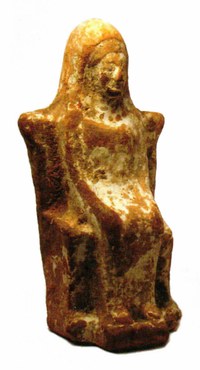T I-40 Enthroned woman
|
|
Enthroned woman, Inv. T I-40 Front side out of the mould. Back smoothed, as is the bottom, no kilning hole.Light beige-brown (10 YR 7/4) clay, abundant engobe; traces of colour: dark blue on the throne, red on the veil, yellow on the necklace. Provenance: Unknown. State of preservation: Intact. Dimensions: H: 10,4 cm; W: 5,6 cm; D: 3,9 cm. References: D. Graen – M. Recke, Herakles & Co. Götter und Helden im antiken Griechenland (Gießen 2010) 48 f. fig. 13 |
Description: A female figure sits on a wing chair that narrows slightly towards the bottom; her hands rest on her knees. A low stool supports the feet, which are in wide, closed shoes. The woman wears a long, tight-fitting chiton and a cloak that covers the head and is symmetrically spread over the shoulders. A pearl necklace adorns the neck. Ribbon-like straight hair forms an arch over the forehead and falls to the shoulders. The elongated face tapers towards the broad chin. The nose is strong, the mouth closed. Large slightly bulging eyes lie under arched brows.
Commentary: Characteristic of this group, which is represented in large numbers in Attica and the Greek heartland, but also in Ionia and Greater Greece, are armchairs with dainty 'ears' and the missing or barely delineated stephanes[1]. In the finds from the Athenian Kerameikos, a development can be observed that extends from the type with a high protruding diadem on an 'ear chair', to thrones with smaller headdresses, to dainty ear chairs that taper downwards[2]. The latter are dated by context[3] to Early Classical times. Occasionally an accentuated back of the head, as found in specimens from western Greece, suggests a tutulus[4]. Mouldings from more precise matrices reveal the forehead hair as a thick bulge[5] or in the form of stylised waves or tongues[6]. Sometimes ear ornaments are indicated plastically[7]. The Giessen statuette T I-40 stands out from the group because of its carefully indicated pearl necklace, but also differs from it in its small head, narrow cheeks and smooth, flat forehead hair. A specimen from Cumae is closest to it[8].
Determination: End of the 1st quarter of the 5th century BC. Attic type, from Greater Greece?
[1] B. Vierneisel-Schlörb, Kerameikos 15. Die figürlichen Terrakotten (München 1997) 29 f. no. 81 pl. 18.
[2] Vierneisel-Schlörb ibid. 27 no. 70 pl. 17. 29 nos. 80. 81 pl. 18.
[3] Id. ibid. 29 f. no. 81 pl. 18. p. 31 no. 91 pl. 20.
[4] L. A. Scatozza Höricht, Le terrecotte figurate di Cuma (Roma 1987) 54 f. no. D Ib' 1. 2 pls. 8 b. c; "aus Italien": U. Liepmann, Griechische Terrakotten, Bronzen, Skulpturen. Kestner-Museum (Hannover 1975) 46 T 19; R. Miller Ammerman, The Sanctuary of Santa Venera at Paestum (Michigan 2002) 98 no. 215 pl. 25.
[5] From Attika: D. Burr Thompson, Miniture Sculpture from the Athenian Agora (Athens 41974) no. 20.
[6] From Attika: Liepmann ibid. 45 f. T 18; V. Mitsopoulos Leon, Brauron. Die Tonstatuetten aus del Heiligtum der Artemis (Athen 2009) 169 nos. 434. 436; Vierneisel-Schlörb ibid. 31 no. 6.7 pl. 20; Winter 1, 1903, 48, 5 with 12 further examples from Athens and Attica; from Tanagra: R. Higgins, Tanagra and the Figurines (London 1987) 96 fig. 109; from Rhodos: C. Blinkenberg, Lindos I. Les petits objets (Berlin 1931) 530 no. 2188 pl. 100; Winter 1, 1903, 52, 2; from Perachora: J. D. Baumbach, The Significance of Votive Offerings in Selected Hera Sanctuaries in the Peloponnese, Ionia and Western Greece (Oxford 2004) 30 fig. 2.41; from Paros: O. Rubensohn, Das Delion von Paros (Wiesbaden 1962) 133 f. nos. T 12. 13. 14 pl. 23.
[7] Burr Thompson ibid. no. 20.
[8] Scatozza Höricht ibid. 55 f. pl. 8 c connects them with korai from the "Euthydikos group", convincing for Akr 684, Richter, Korai fig. 578.


